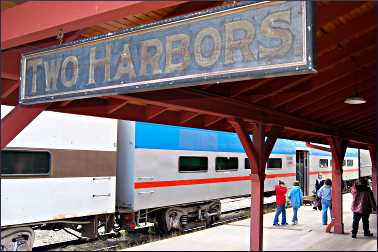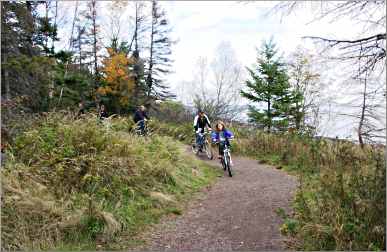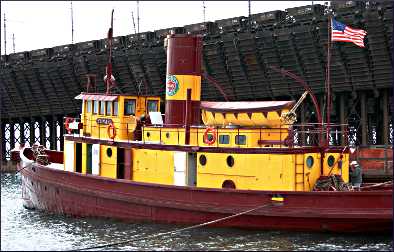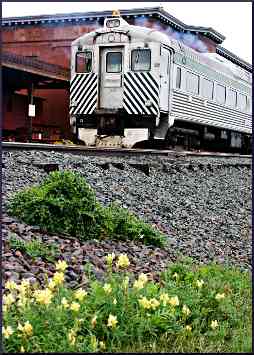The Lighthouse Express
Between Duluth and Two Harbors, vintage trains take passengers back to the past.

© Beth Gauper
Once, passenger trains crisscrossed the state, and lighthouses guided sailors on the Great Lakes.
Trains and lighthouses are beloved relics now, symbols of a simpler past. In the digital age, they seem antique, like Grandpa's buggy or Grandma's butter churn.
But don't relegate them to history's dustbin just yet.
There's still a train out of Duluth, and it takes passengers to the depot in Two Harbors. On weekends, passengers can bring their bags, stay overnight and return on the next day's train.
Two Harbors, once a busy transportation hub, is quiet these days. But rail cars loaded with iron ore still rumble down from the Iron Range and up to the docks, as they have since 1884.
Now, the ore is in taconite pellets, still steaming from the furnace. Nearly every day, massive boats glide in to get them. From the shore or break wall, onlookers can watch the dusty red pellets dropping from 75-foot chutes into bins on the boats.
Across the water, the Edna G. looks ready to work, as she has been since she went into service in 1896. The tug was the St. Bernard of the North Shore, rescuing hundreds of sailors and boats from tight spots until she retired in 1981.
Tourists hurrying up to the North Shore often miss the lighthouse, docks and depot. But on the railroad, they're delivered right to the door.
Late one September, my husband and I boarded the North Shore Scenic Railroad for the trip to Two Harbors.
In a 1950 diesel Budd car, we chugged past Bayfront Park, the William Irvin and the Aerial Lift Bridge, under which a Coast Guard boat had just passed.

© Torsten Muller
"It would take all four of the other Great Lakes plus three extra Lake Hurons to fill Lake Superior," car host Joanne Johnson told us. "You could put the Empire State Building in the deepest part of the lake and still have more than 100 feet of water over it."
People out for a morning stroll waved as we followed the Lakewalk, then moved inland. After we crossed the Lester River, we approached Minnesota 61, and the engineer blew his whistle furiously to alert traffic.
Then, we were across the highway and passing Kitchi-Gammi Park on Lake Superior.
"Now, we're getting ready to zoom," Johnson said wryly. "So, we'll be clipping along at 30 miles per hour."
Mostly we saw trees, but in fall, that was a quite a show. And we got beautiful views of rivers from the high railroad bridges.
"The movie 'Iron Will' used this bridge over the Sucker River," Johnson told us. "They had to spray the trees with potato flakes because not enough snow fell that year."
This rail corridor once was called the Lakefront Line, and freight cars carried goods to the Iron Range and brought back pine logs for Duluth's sawmill.
There were passenger trains, too, and in the early days, they carried resort guests to Lake Vermilion and dropped off fishermen at trout streams along the way.
Later, passengers rode a self-propelled Budd car like ours, until service was discontinued in 1961.
We got to Two Harbors at noon and walked up to the highway for lunch at the Vanilla Bean. As we ate, we watched weekend traffic rushing up the North Shore.
There's a sign on the highway pointing to the lighthouse, harbor and downtown less than a mile away, but few were heeding it. Now, however, the Castle Danger Brewing taproom is pulling more tourists toward the old downtown.

© Beth Gauper
Checking into a lighthouse
There are several places to stay overnight in Two Harbors, but we had reserved at the Lighthouse B&B, which is owned and operated by the Lake County Historical Society.
Walking along the bay to the B&B, we dropped our bags in the Keeper's Room. Then, we went outside to Lighthouse Point and strolled through wildflowers and old cedars on the Sonju Trail.
The point essentially is a hardened flow of lava; at its craggy edges, there are lichen-covered nooks and crannies where people can sit and watch the lake and passing boats.
From there, we walked past the public boat launch and over to the Edna G., across land once called Whiskey Row for its saloons.
The little tug was at its best when disaster struck, rescuing 13 men from the wrecked Niagara in 1904 and 24 from the Edenborn during the big storm of 1905.
For nearly a century, she pulled boats off reefs and broke through ice, often damaging herself.
She was the last coal-powered boat to operate on the Great Lakes.
"Once, a fireman loaded 2 tons of coal over a 17-hour shift and he lost 13 pounds," historical-society volunteer Bob Munson told us.
The Edna G. already was retired when the pilothouse of the Frontenac, which ran aground in a 1979 snow squall, was scrapped and brought to rest on the front lawn of the lighthouse. The pilothouse now holds exhibits, including the bill of lading for the Edmund Fitzgerald's last load.
Ghosts from the past
As it grew dark, we decided to settle into the lighthouse and order in pizza. As innkeeper Lana Harris got a head start on the next day's breakfast, she told us about the ghosts some people report seeing.
"(Former Minnesota attorney general) Mike Hatch came with his mother, and they heard someone scrabbling around in the kitchen," Harris said. "There was a single woman staying in the Skiff House, a nurse or scientist, who said a vase moved on the table and she felt someone lie on the bed.
"When I started working here, I had a conversation with the ghost: 'I don't want you bothering me when I'm here working alone.' "

© Beth Gauper
Only one person died at the lighthouse, a 24-year-old keeper's daughter who had heart and kidney disease. That was in 1902.
Kathy Meyer, the wife of the last keeper, was ill when the Coast Guard turned over the lighthouse to the historical society in 1987 and she had to leave, but she didn't die until 1999.
She did love the lighthouse, and her ashes were scattered over the lake in front of it.
In the evening, we sat in the parlor, nibbling Key lime cookies and reading more about the lighthouse. There were other reports of odd phenomena: a bouncing ball of light in the Frontenac, the smell of pipe tobacco, an old gentleman in the window.
That night, I awoke to the crack of a flag whipping in the wind and got up to close the window. But there was no flag.
When I got up in the morning, Avis and Bob Savre of Longville, Minn., already had put up the flag, and I asked them if the lines had been loose. Avis Savre's eyes grew wide.
"She was here!" she said. "We chased her away. At least she didn't come in the house."
Over breakfast, we talked to the other guests. Charlotte Hipscher of Hudson, Wis., had reserved her lighthouse room as an anniversary surprise for her husband, Michael.

© Beth Gauper
"I like the views and the history," Michael Hipscher said.
"Whenever we see a lighthouse, vroom, we have to go there," his wife said.
Their keeper's duty had been to monitor the rotation of the two beacons, which each flash three times a minute and can be seen from 17 miles away in good conditions. The society maintains the light as a navigational aid to private boats and aircraft.
"Last night, we went up to the tower and opened all the portholes," Charlotte Hipscher said. "It's fascinating; it's like being in a fish bowl."
With the rest of our time, we visited the assistant keeper's house, which holds a display on local shipwrecks and photos of the ore boats that visit Agate Bay: the Arthur Anderson, the Edwin Gott, the Roger Blough.
Then we got back on the train. For the return, it included a 1962 Soo Line 700 locomotive, two 1960s bilevel cars, an open car and a caboose to accommodate a fall-color crowd of more than 200.
Everyone got to see the historic lighthouse, flaming red in the midday sun. But only we had served it "with honor and distinction," and we had the certificate to prove it.
Trip Tips: Taking the train to Two Harbors on the North Shore

© Beth Gauper
Book both lighthouse and trail as early as possible for weekends in fall.
North Shore Scenic Railroad: The 26-mile run to and from Two Harbors leaves Duluth at 10 a.m., arrives in Two Harbors from noon to 12:30 p.m. and returns to Duluth between 4 and 5 p.m., Friday through Sunday from July to the third weekend in October.
Accommodations: The Lighthouse B&B has three spare but tasteful rooms. They share one bathroom, and there's a half-bath in the basement.
The Skiff House, on the grounds adjoining the visitors center, has its own bathroom and hot tub. The inn is run by volunteers from the historical society, 888-832-5606.
For more about the area, see Discovering Two Harbors.
Boat-watching: Agate Bay receives an average of about one boat a day, and boat arrival times are estimated by the Lake Superior Maritime Visitor Center in Duluth.
They're listed on the Harbor Lookout site.
Museums: The Lake County Historical Society sells tickets at the Depot for the three museums it runs, the Depot, the lighthouse and the 3M Museum.